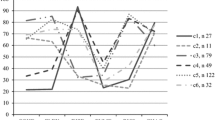Abstract
Two basic assumptions of the Circumplex Model of family systems were evaluated: (1) Healthy families evidence balanced degrees of cohesion and adaptability, whereas problem families evidence extreme degrees, and (2) families with balanced degrees of cohesion and adaptability possess more positive communication skills than families with extreme degrees. Subjects were 58 mother-son dyads from father-absent families. In 29 of the families the adolescent was a juvenile offender, while in the remaining families there was no history of arrest or psychiatric referral. The dyads completed the Family Adaptability and Cohesion Scales (FACES) and an unrevealed differences interaction task. FACES was highly proficient at differentiating delinquent from nondelinquent families. Moreover, in families with balanced degrees of cohesion and adaptability, the mothers' communication was significantly more supportive and explicit, and the dyads evidenced significantly greater warmth and affection than dyads with extreme degrees.
Similar content being viewed by others
References
Alexander, B. B., Johnson, S. B., Carter, R. L. (1984). A psychometric study of the family adaptability and cohesion scales.Journal of Abnormal Child Psychology, 12, 199–208.
Alexander, J. F. (1973a). Defensive and supportive communications in family systems.Journal of Marriage and the Family, 35, 613–617.
Alexander, J. F. (1973b). Defensive and supportive communications in normal and deviant families.Journal of Consulting and Clinical Psychology, 40, 223–231.
Aponte, H. J. (1976). Underorganization in the poor family. In P. J. Guerin (Ed.),Family Therapy (pp. 432–448). New York: Gardner.
Beal, E. M. (1980). Separation, divorce, and single parent families. In E. A. Carter & M. McGoldrick (Eds.),The family life cycle: A framework for family therapy (pp. 241 -264). New York: Gardner.
Bilbro, T. L., & Dreyer, A. S. (1981). A methodological study of a measure of family cohesion.Family Process, 20, 419–427.
Biller, H. B. (1974).Paternal deprivation: Family, school, sexuality and society. Lexington, Massachusetts: D. C. Heath.
Colon, F. (1980). The family life cycle of the multiproblem poor family. In E. A. Carter & M. McGoldrick (Eds.),The family life cycle: A framework for family therapy (pp. 343–381). New York: Gardner.
Druckman, J. (1979). A family oriented policy and treatment program for juvenile status offenders.Journal of Marriage and the Family, 41, 627–636.
Ferreira, A., & Winter, W. (1968). Information exchange and silence in normal and abnormal families.Family Process, 7, 251–276.
Garbarino, J., Sebes, J., & Schellenbach, C. (1984). Families at risk for destructive parent-child relations in adolescence.Child Development, 55, 174–183.
Hanson, C. L., Henggeler, S. W., Haefele, W. F., & Rodick, J. D. (1984). Demographic, individual, and family relationship correlates of serious and repeated crime among adolescents and their siblings.Journal of Consulting and Clinical Psychology, 52, 528–538.
Henggeler, S. W., & Tavormina, J. B. (1980). Social class differences in family interaction: Pathological, normative, or confounding methodological factors.Journal of Genetic Psychology, 137, 211–222.
Hetherington, E. M., & Frankie, G. (1967). Effects of parental dominance, warmth and conflict on imitation in children.Journal of Personality and Social Psychology, 6, 119–125.
Hollingshead, A. B., & Redlich, F. C. (1958).Social class and mental illness. New York: Wiley.
Killorin, E. & Olson, D. (1980).Clinical application of the Circumflex Model to chemically dependent families. Unpublished manuscript.
Martin, B. (1975). Parent-child relations. In F. D. Horowitz, E. M. Hetherington, S. Scarr-Salapatek, & G. M. Siegel (Eds.),Review of child development research (Vol. 4, pp. 463–540). Chicago: University of Chicago Press.
Minuchin, S., Montalvo, B., Guerney, B. G., Rosman, B. C., & Schumer, F. (1967).Families of the slums. New York: Basic Books.
Olson, D. H., Bell, R., & Portner, J. (1978).Family adaptability and cohesion evaluation scales. Unpublished manuscript, Family Social Science Department, University of Minnesota.
Olson, D. H., McCubbin, H. I., Barnes, H., Larsen, A., Muxen, M., & Wilson, M. (1982).Family inventories. University of Minnesota.
Olson, D. H., Russell, C., & Sprenkle, D. (1983). Circumplex Model of marital and family systems VI: Theoretical update.Family Process, 22, 69–83.
Olson, D. H., Sprenkle, D., & Russell, C. (1979). Circumplex Model of marital and family systems I: Cohesion and adaptability dimensions, family types, and clinical applications.Family Process, 18, 3–28.
Russell, C. (1979). Circumplex Model of family systems III: Empirical evaluation with families.Family Process, 18, 29–45.
Severy, L. J., & Morton, D. S. (1982).Memphis-Metro Youth Diversion Project: Local evaluation final report. Memphis: U.S. Department of Justice, Office of Juvenile Justice and Delinquency Prevention.
Sprenkle, D., & Olson, D. H. (1978). Circumplex Model of marital systems IV: Empirical study of clinic and non-clinic couples.Journal of Marriage and Family Counseling, 4, 59–74.
Author information
Authors and Affiliations
Additional information
This research was supported by funding to the Department of Psychology at Memphis State University granted through the Centers of Excellence Program of the State of Tennessee. We thank the staff of the Memphis-Metro Youth Diversion Project for their consideration and assistance.
Rights and permissions
About this article
Cite this article
Rodick, J.D., Henggeler, S.W. & Hanson, C.L. An evaluation of the family adaptability and cohesion evaluation scales and the circumplex model. J Abnorm Child Psychol 14, 77–87 (1986). https://doi.org/10.1007/BF00917223
Issue Date:
DOI: https://doi.org/10.1007/BF00917223



